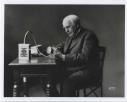 |
| Thomas A. Edison (www.google.com) |
Thomas Edison was born in Milan, Ohio, in 1847. In 1854, the family settled in Port Huron, Michigan, where Edison attended school for three months. This was his only formal public education. His mother continued his education, teaching him reading, writing and arithmetic. She also read to him from well-known English writers, such as Edward Gibbon, William Shakespeare and Charles Dickens. Edison earned a job selling newspapers, apples, and candy on the Detroit and Port Huron branch of the Grand Trunk Railroad when he was only 12 years old.
Around this time, his hearing began to decline, possibly due to a childhood attack of scarlet fever.
Edison once said that he sometimes considered his partial deafness almost an asset, particularly when he wanted to concentrate on an experiment. However, in a poignant entry in his diary some years later, he wrote, "I haven't heard a bird sing since I was 12 years old."
 |
In the summer of 1862, Edison saved a boy from being run over by a boxcar. The boy, only three years old, was the son of the stationmaster in Mount Clemens, Michigan. In gratitude, the stationmaster offered to teach Edison how to operate the telegraph. Edison had already experimented with the telegraph at home and gladly accepted the offer. For five months, he learned to send and receive dispatches, and for the next four years, he traveled thousands of miles as a telegrapher. During this period he spent most of his salary on various laboratory and electrical instruments, which he would take apart and rebuild.
In 1876, Edison established a laboratory at Menlo Park, New Jersey—the world's first laboratory dedicated to industrial research. Within 10 years, people throughout the world knew Edison as the Wizard of Menlo Park. Edison worked on his experiments with extraordinary intensity. He lived in his laboratory, getting along on four hours of sleep a day and eating meals brought to him by an assistant. He often kept vigils of 48 and even 72 hours when an experiment neared completion. Often, as in the cases of the electric light, the storage battery, and the experiments on synthetic rubber, success or failure depended on the discovery of a suitable material. In each case, he conducted thousands of experiments to find the right materials. Before starting an experiment, Edison tried to read all the literature on the subject to avoid repeating experiments that other people had already conducted. Perhaps the best illustration of Edison's working methods is his own famous statement, "Genius is one percent inspiration and 99 percent perspiration."
 |
| lamp |
After patenting the phonograph, Edison set out to develop an incandescent lamp, which would produce light by heating a wire until it glowed brightly. People already used electric arc lights, which produced light by creating an arc of electricity between two wires. However, the blinding glare these arc lights gave off made them unsuitable for home use. Edison, like others before him, conceived the idea of a light with a glowing wire, or filament, made of a substance that could endure very high temperatures without fusing, melting or burning out. After hundreds of trials and more than a year of steady work, Edison developed a high-resistance carbon-thread filament that burned steadily for more than 40 hours. Although not the first incandescent electric light, it was the first practical one because it used a small current and, in addition, lasted a long time without burning out.
 |
| Edison Monument |
When Edison died, the U.S. government considered turning off all electric current in the country for a minute or two as a tribute to him. It became apparent, however, that the operation of the great electrical distribution systems of the nation could not be interrupted even for a moment without possibly disastrous effects. Within Edison’s lifetime, the system that he had pioneered had become essential to the world's way of life.
Page created on 8/29/2011 12:00:00 AM
Last edited 8/29/2011 12:00:00 AM
